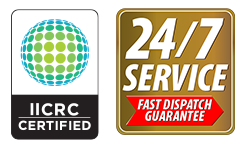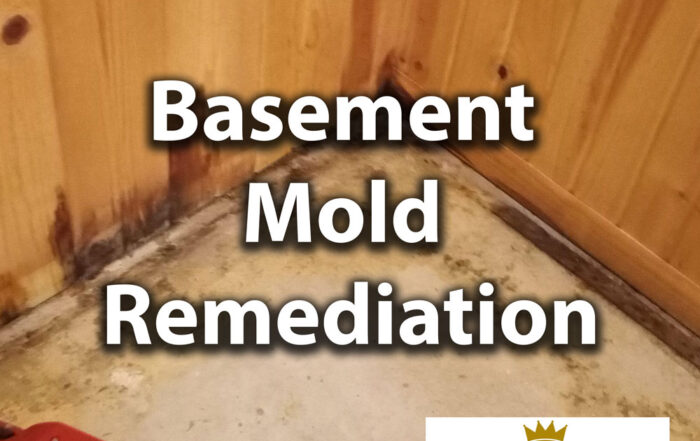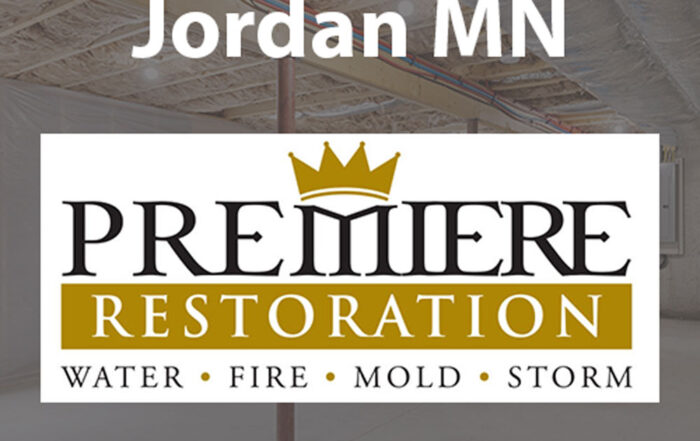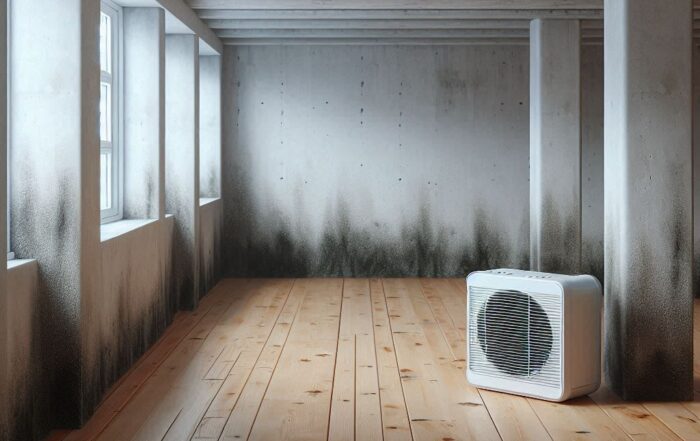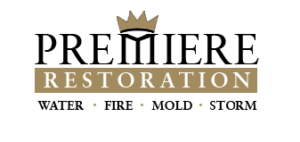Commercial Mold Remediation
Removing Mold From Commercial Buildings and Industry
Mold Removal & Remediation in Commercial Buildings
Mold, a type of fungus, is part of the same family as mushrooms and yeasts. It can be found both indoors and outdoors. Mold thrives in moist environments around roof leaks, windows, pipes, and areas affected by flooding or water used to extinguish fires. Controlling the moisture levels in your building is crucial to providing a safe indoor environment for your building’s occupants.
After a fire or flood, the opportunity for mold growth grows exponentially and must be addressed immediately.
Mold can create serious adverse health effects for occupants in your building, especially for occupants with asthma or other respiratory problems. Depending on the type of mold, it can off-gas toxic substances that could lead to headaches, sneezing, lethargy, and other factors.
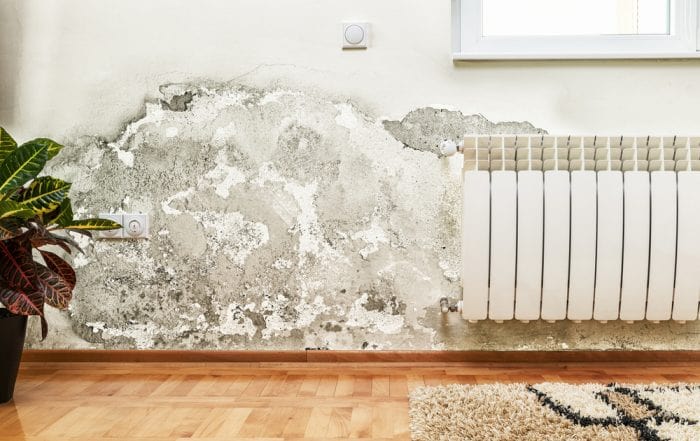
Why Hire Premiere Restoration
Speed
Mold grows quickly, so you need us in your facility promptly. Premiere Restoration guarantees to dispatch a crew within 15 minutes of your call. We are local and in your area.
Knowledge and Experience
Premiere Restoration is certified and trained in water damage restoration and mold remediation. We have been serving southern Minnesota since 1996.
Competence
We are licensed contractors and certified by the IICRC. Premiere Restoration meets or exceeds industry standards and best practices while performing mold remediation and water damage restoration.
We are Local and Near You
Premiere Restoration is headquartered in Mankato, Minnesota. We provide Mold Damage Remediation services to all of Southern Minnesota, including Mankato, Faribault, Lake Crystal, New Ulm, North Mankato, Owatonna, Saint Peter, and Waseca.
Mold can be a Silent Saboteur
Mold gradually consumes organic materials within business buildings. Its insidious growth can lead to structural issues and the deterioration of various materials.
Wood and Paper:
Mold thrives on cellulose-rich materials like wood, paper, and cardboard. It infiltrates wooden beams, flooring, and furniture. Over time, it weakens the wood fibers, causing warping, rot, and eventual structural instability.
Drywall and Ceiling Tiles:
Mold can infiltrate drywall and ceiling tiles, especially if they have absorbed moisture due to leaks or high humidity. It weakens the material, leading to sagging, discoloration, and potential collapse.
Insulation:
Mold growth within insulation reduces its effectiveness. It can also release spores into the air, affecting indoor air quality.
Fabrics and Upholstery:
Mold feeds on fabrics, upholstery, and carpets. It stains and weakens these materials, rendering them unsightly and potentially unusable.
HVAC Systems:
Mold can colonize air ducts, coils, and filters. As air circulates, it spreads mold spores throughout the building, affecting occupants’ health and potentially damaging the HVAC system.
Paint and Wallpaper: Mold can grow beneath wallpaper or behind layers of paint. It causes peeling, bubbling, and discoloration.
Basements and Foundations:
Mold in basements or crawl spaces can weaken concrete foundations. It can also corrode metal supports and compromise structural integrity.
Roofing Materials:
Roof leaks allow moisture to penetrate roofing materials. Mold growth weakens shingles, tiles, and sheathing.
Electrical Components:
Mold can infiltrate electrical panels, wires, and outlets. This poses safety risks and can lead to malfunctioning systems.
Avoid Mold by Removeing Moisture Quickly!
Mold requires the following conditions to grow:
- Mold spores – Always present in the air, indoors and outdoors
- Food supply – Anything organic such as documents, books, carpets, clothing, wood, drywall, etc.
- Source of moisture – The only practical factor you can control in most houses.
If allowed to grow inside your facility, mold can be a problem because it can damage your buildings, equipment, inventory and cause employee health problems.
Mold Remediation in Commercial Facilities
Mold remediation in business offices and facilities involves a systematic approach to safely and effectively remove mold and prevent its recurrence. Here are the key steps:
1. Assessment
- Evaluate the extent of mold contamination and identify affected areas.
- Determine the type of damaged materials (e.g., walls, flooring, cabinetry).
- Assess the severity of the moisture problem causing mold growth.
2. Containment
- Isolate the affected area to prevent mold spores from spreading.
- Use plastic sheeting and negative air pressure to create containment zones.
3. Removal of Mold-Damaged Materials
- Remove wet and moldy loose building materials, furnishings, and décor.
- Open up wet and moldy walls, and remove the flooring and affected cabinetry.
- Vacuum debris from demolition using a wet/dry HEPA vacuum.
4. Fungicide Treatment
- Spray affected materials with fungicide.
- Place these materials in doubled-up construction trash bags (double bagging) with a 6-mil thickness.
5. Contents Restoration
- Our state-of-the-art contents cleaning trailer can clean much of your damaged personal property on-site.
- You can watch the cleaning and restoration process every step of the way.
6. Address the Water Source
- Identify and rectify the water source that led to mold growth.
- Fix leaks, improve ventilation, and address humidity issues.
7. Monitoring
- Regularly monitor the remediated area to ensure mold does not return.
- Followup inspections and mold testing as needed
Remember that Premiere Restoration’s professional mold remediation expertise is crucial for effective mold remediation in business settings. We can seek additional assistance from industrial hygienists or environmental health professionals when needed. As a licensed general contractor, Premiere Restoration can not only remediate the mold damage but also repair the damaged areas and rebuild the affected structures as needed.
Mold Remediation Safety Precautions
Exposure to damp and moldy environments can lead to various health effects. Some people are sensitive to molds, experiencing symptoms like stuffy nose, wheezing, red or itchy eyes, or skin irritation. Individuals with allergies or asthma may have more intense reactions. Severe reactions can occur among workers exposed to large amounts of molds in occupational settings.
Here are some essential steps taken by our team at Premiere Restoration:
Isolate the Cleanup Area
- Create a containment zone to prevent unprotected individuals from entering the affected area.
- Use plastic sheeting and negative air pressure to limit mold spore dispersion.
Personal Protective Equipment (PPE)
- Always wear appropriate PPE, including:
- Respirator: Use an N-95 or P-100 respirator to filter out mold spores.
- Gloves: Protect your hands from direct contact with mold-contaminated materials.
- Protection: Wear goggles to shield your eyes.
- Clothing: Use old clothes and shoes that can be laundered or discarded after cleanup.
Avoid Direct Contact with Mold
- Refrain from touching mold with bare hands.
- Prevent skin contact and inhalation of mold spores.
- Be cautious when checking behind wallpaper or wall coverings to avoid spore release.
Remember that large mold infestations are usually visible or detectable by smell. If you suspect mold in your business office, warehouse, shop floor, or industrial facility, call the mold remediation experts at Premiere Restoration to address it promptly. It is essential for your employee’s health and your facility’s structural integrity.
Preventing Mold Growth
After a Flood or Fire: Call Premiere Restoration immediately to remove the water and dry out your facilities. Start the Water Damage Restoration Process before mold takes hold, creating an even greater problem.
Have your maintenance crew fix plumbing leaks: Excessive moisture can create a prime environment for mold growth. Leaky pipes are the first culprit for mold to form and the easiest to fix.
Be aware of condensation: Condensation may seem harmless, but it’s a powerful source of moisture. Mold only needs 24-48 hours to spread. You can prevent moisture in the air by adding dehumidifiers or increasing the circulation throughout the space. This can be done with additional fans or ventilation in the HVAC system.
Keep HVAC systems running smoothly: Have your maintenance crew check any drip pants to ensure they are being emptied correctly. Moisture can accumulate and create conditions for mold growth if not. Also, have your crew check for obstructions in the HVAC system to ensure condensation is not accumulating where it shouldn’t.
Vent moisture outside: If you have equipment such as dryers, boilers, or heat-generating equipment, make sure that any steam or condensation is vented outside. This way, moisture will not become trapped in the walls.
Low humidity is key: Ensure the humidity levels are below 60% within the building. Ideal ranges would be 30-50%, if possible. Dehumidifiers can help keep the moisture levels down.
Keep foundations dry: One area commonly missed is the foundation of the structure. If this area is wet due to ineffective drainage, mold can start colonizing and grow right at the base of the building. In order to prevent this from occurring, build a slope to provide drainage to drain away from the foundation.
Hidden Sources of Dampness Leading to Mold Growth
Water damage from putting out a fire or the results of a flood or plumbing leak can be obvious and should be treated for mold growth as part of an overall damage restoration project. But moisture that allows mold to grow can be elusive, especially when it lurks within concealed spaces. Here are some scenarios where dampness might be less obvious yet allow mold to grow.
Leaky Roofs and Windows: Water infiltration through damaged roofs, cracked windows, or poorly sealed openings can create damp areas where mold can thrive.
Flooding: After a flood, residual moisture in walls, floors, and furniture can lead to mold growth if not addressed promptly.
Plumbing Leaks: Leaky pipes, faucets, or water supply lines can lead to hidden moisture buildup within walls, ceilings, or floors.
Condensation: Excessive condensation on windows, walls, or cold surfaces can create a conducive environment for mold growth. This often occurs in bathrooms, kitchens, and poorly ventilated spaces.
High Humidity: Areas with consistently high humidity levels, such as basements, crawl spaces, and poorly ventilated bathrooms, are prone to mold infestations.
Poor Ventilation: Inadequate airflow prevents moisture from dissipating, promoting mold growth. Check ventilation systems, exhaust fans, and air circulation in your home.
Wet Materials: Items like wet rugs, damp clothing, or soaked upholstery can harbor mold if not dried promptly.
Basements and Crawl Spaces: These areas are susceptible due to their proximity to soil moisture and potential water seepage.
Improperly Sealed Foundations: Cracks or gaps in foundations can allow water to seep into basements or crawl spaces.
Poor Drainage: Improperly graded landscapes or clogged gutters can cause water accumulation near the foundation, leading to dampness.
Remember to promptly address these hidden sources of dampness to prevent mold growth and maintain a healthy living environment. Regular inspections and proper maintenance are crucial in keeping mold at bay. If you have water issues or detect mold, call the mold remediation experts at Premiere Restoration.
Read More About Mold Damage
Mold Removal in Mankato, MN: Professional Mold Remediation
How to Prevent Mold Growth During Humid Summer Months Protect Your Home from Hidden Moisture Hazards: Mold Removal in Mankato As the temperature rises and the air thickens with humidity, summer becomes the perfect [...]
Basement Water Damage Restoration and Repairs in Jordan, MN
A Hidden Threat: How to Spot and Stop Water Damage in Your Jordan, MN Home Basement Basement Water Damage in Jordan, MN. When most Minnesota homeowners think of water damage, they picture a flood [...]
Flooding Leads to Water Damage
The historic flooding that first hit southern Minnesota in June continues in many areas. Premiere Restoration continues to receive calls asking for water damage cleanup and restoration around Mankato, Waterville, and New Ulm.
More Articles
Premiere Restoration specializes in helping to recover and restore your property while minimizing your inconvenience.
Premiere Restoration helps commercial businesses prepare a Disaster Emergency Response Plan to prepare for emergencies and quickly recover from disasters.
We can measure your air quality and, if needed, remove the cause or install filtration and purification systems.
Certified by the IICRC, we have taken the proper coursework and rigorous testing to handle any sewage damage situation.



